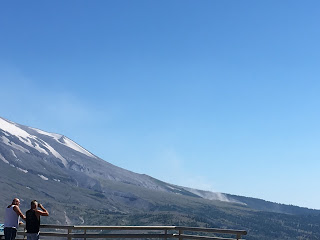Amazingly enough, over the course of 1980, fewer than 60 people died from the eruptions. I know that sounds like a high number, but, if I remember Professor Finnigan's class correctly, the St. Helens eruption was the same kind of eruption as Vesuvius in Italy, which wiped out two entire towns. So to me, the St. Helens story is both an indication of just how immensely powerful nature is and how you do not mess with it, but also how humans can be smart, adaptable, and determined to survive.
I bring all this up because while family visited, we decided to take a day trip out to St. Helens. I'd been there before as part of the yearly sixth grade overnight field trip there, but that was before I even started writing Darkwoods, so let's just say my memory of it is iffy. What I do remember about that time was that the mountain was going through a second series of eruptions around the time we were there; they were comparatively minor, but the year after us, the field trip was cancelled because it wasn't safe. Ah, volcanoes!
Anyway, on the way down, we stopped off at Olympia, because it was on our way, and my youngest cousin wants to get his picture taken in front of every state capitol (why didn't I think of that when I was a kid?). I wasn't going to mention it, because I already have a post about Olympia on my Travel Blog, but Google photos decided to stylize one of my photos from the trip. I think it looks cool, so:
After Olympia, we drove another hour and a half or so to get to Mt. St. Helens. To be clear, when you "go to Mt. St. Helens", you don't actually set foot on the mountain itself; what that actually means is that you go to the national memorial park, which has a couple of observatories, vantage points, and scientific exhibits that tell you about the mountain's history.
So - cue the photos!
First are some pictures from the car. See that gray in the middle of this first one? That, we think, is one of the stretches of land devastated by the mudflow:
For context, here's a picture of the forest on a nearby mountain:
 |
| Here is the mudflow scar again |
The thing about St. Helens is that it is, in fact, still an active volcano, which means there's still a lot of very hot and pressurized activity inside it. The good thing is that there are enough vents on the mountain to let off some of that pressure, so the odds of another explosive eruption happening anytime soon are slim. It also means there are clouds of steam coming off the mountain:
 |
| To the right, down the slope in this picture |
 |
| On the lower left side of the crater in this one |
 |
| Lower left side of the crater |
That bulge is the lava dome. As in, there is live lava pushing up under that rock, that will one day rebuild the entire dome. I think St. Helens lost about a thousand feet of height, but from what I can see, that dome has made pretty good progress in less than 40 years. Who knows when it'll all be made up?
By the way, if you ever go to the observatories, be prepared to be as familiar with St. Helens before the eruption as after. It's pretty mind-blowing how much a mountain, a mountain, can change in just one day. I do highly recommend going to the observatories, because there is so much to learn there. I've hardly touched on the story of the mountain, and the observatories show the equipment they use to measure volcanic activity, a light-up model that shows all the different stages of the eruption, and a lot of information about the forests around the mountain and how the eruption affected them. It's a spectacular learning experience.
Plus, you get to see cute guys like this!








No comments:
Post a Comment